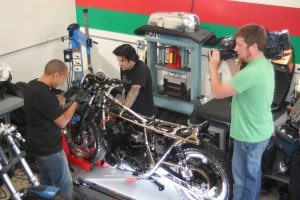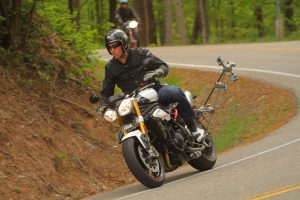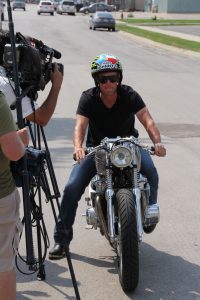Ten Years Since Cafe Racer TV
Times tends to just zip by when you’re busy, causing the mind and memory to override the recent past almost automatically. However, this week marked ten years since the final season of our acclaimed “Cafe Racer TV” series ended production. The series ran for an incredible 56 episodes and was eventually renamed “Naked Speed,” by the suits at Discovery Communications for its final run in 2014/15. I had actually proposed the series to the team at Atlanta’s Chet Burks Productions way back in 2008 and they agreed to take a chance producing a half-hour documentary that aired on Discovery’s high-definition channel in fall of 2009. cafe Racer motorcycles and the people who ride and build them have bene with us since just after the close of WWII, but few, if any, Us media outlets paid much attention to the burgeoning movement back then. If you saw a two-wheeler on TV, chances are it was a stretched-out neo-chopper, a style of machine that had proven extremely profitable for cable networks since the early 200s.
I’m still mightily impressed that Discovery’s programming bigwigs were willing to grant broadcast time to a documentary about an obscure, British-based motorcycle subculture, but they took the risk and the results proved far more auspicious than any of us could have imagined. Within months of the first show’s airing, the network ordered two full seasons of 30-minute episodes, forever changing the face of motorcycles on American TV.
That’s not just hyperbole- consider how “Cafe Racer” became the first broadcast series ever to air that rode around the usual fare of manufactured in-shop arguments, phony time-sensitive builds and the macho bullshit associated with programs like “Monster Garage” and “American Chopper.” For once the public was presented with a view of motorcycles that was based on history, technology and a genuine love of riding fast, customized bikes. Though there were many heated discussions amongst the crew on the direction “Cafe Racer” should take and budgetary constraints at every turn, the decision to take the series on the road proved another smart one.
Instead of simply filming each episode inside a single garage, the production crews (there were several working at any given time) hit the road, traveling across the Atlantic to Europe and the UK where the history and future of ton-up motorcycles still thrives. Unexpectedly, the number of shops and individual technicians designing and creating unique, high-performance customs burgeoned back home as well, creating a deep pool of potential subjects for the series.
It was hard work, far harder, in fact, than any of us could have anticipated. The days of shooting on camera sometimes carried on past the 12-hour mark, in all sorts of weather. Meanwhile the disparate personalities and business interests involved made for some truly crazy times. I wasn’t quite prepared for the mania surrounding so-called “reality TV” at the time, a public obsession that changed our daily lives in many ways. Suddenly, it became difficult to enjoy attending motorcycle rallies I’d been visiting for years as countless punters felt compelled to approach me, asking – sometimes demanding- their own shot on the series. Oftentimes, we were deluged with pressure to launch all-new series based on wild, untested ideas fostered by the friends and families of the show’s many guest mechanics- I still have a file chock-a-block with treatments and amateur scripts sent my way by would-be TV stars.
Suddenly, doors were being opened that were never even accessible before, with everyone from aftermarket parts suppliers to neighborhood barflies all vying for a set at the table.
Still, there were plenty of amazing, cool memories. Veteran riders would turn up during our stints filming at London’s Ace Cafe with rare, dog-eared old photos of them and their riding buddies from years gone by and people generously shared their personal tales with us much to the global viewership’s enjoyment. We made some lifelong friends whom we still visit and keep in touch with some of whom have become regular contributors to Cafe Racer magazine. Superbike champ brother Ben and Eric Bostrom were true gentlemen, easy to work with and eager to enjoy the experience, while the hard work of the crew and support teams was remarkable.
But in the end, it all became a bit much as the demands of publishing a growing bi-monthly magazine, building and maintaining my own bikes and hosting a TV series with a full travel schedule became overwhelming.
I remember sipping a pint of Guinness at the Dublin brewery when a call came through from “Naked Speed’s” producers informing me that a sixth season was not in the cards. It was a feeling of absolute relief, as if I’d suddenly been given a ticket back to my boring, old life, one where nobody demanded selfies or autographs and I could once again show my face at motorcycle rallies without being asked to cast people in TV shows. The results of all that craziness and hard work are still something I’m quite proud of; watched today, “Cafe Racer TV” was intelligently written, well-produced and often filled with the sort of fun, historical coverage so often missing from cable TV. Our main goal wasn’t to become TV personalities or to overdose on our own egos, but to provide the public with an accurate telling of the clever, Mid-Century riders and engineers who made fast streetbikes possible. They risked life and limb to improve upon the sometimes wonky motorbikes then available, and sharing the stories of folks like Dave Degens of Dresda Tritons, the 59 Club’s Fr. Graham Hullet and Dave Johnson and countless others was one of my proudest achievements as a journalist.
If you’ve never seen the series, check it out- you’ll be surprised at how well “Cafe Racer” holds up even a decade later










